Long-Distance High-Power Wireless Optical Energy Transmission Based on VECSELs
Abstract
1. Introduction
2. System Overview
3. Experimental Results
4. Conclusions
Author Contributions
Funding
Institutional Review Board Statement
Informed Consent Statement
Data Availability Statement
Conflicts of Interest
References
- Sodhro, A.H.; Awad, A.I.; van de Beek, J.; Nikolakopoulos, G. Intelligent authentication of 5G healthcare devices: A survey. Internet Things 2022, 20, 100610. [Google Scholar] [CrossRef]
- Singh, P.; Elmi, Z.; Meriga, V.K.; Pasha, J.; Dulebenets, M.A. Internet of Things for sustainable railway transportation: Past, present, and future. Clean. Logist. Supply Chain. 2022, 4, 100065. [Google Scholar] [CrossRef]
- Singh, P.; Elmi, Z.; Lau, Y.; Borowska-Stefańska, M.; Wiśniewski, S.; Dulebenets, M.A. Blockchain and AI Technology Convergence: Applications in Transportation Systems. Veh. Commun. 2022, 38, 100521. [Google Scholar] [CrossRef]
- Goswami, H.; Choudhury, H. Remote Registration and Group Authentication of IoT Devices in 5G Cellular Network. Comput. Secur. 2022, 120, 102806. [Google Scholar] [CrossRef]
- Singh, P.; Dulebenets, M.A.; Pasha, J.; Gonzalez, E.D.S.; Lau, Y.Y.; Kampmann, R. Deployment of autonomous trains in rail transportation: Current trends and existing challenges. IEEE Access 2021, 9, 91427–91461. [Google Scholar] [CrossRef]
- Delgado-Santos, P.; Stragapede, G.; Tolosana, R.; Guest, R.; Deravi, F.; Vera-Rodriguez, R. A survey of privacy vulnerabilities of mobile device sensors. ACM Comput. Surv. (CSUR) 2022, 54, 1–30. [Google Scholar] [CrossRef]
- Lu, F.; Zhang, H.; Mi, C. A review on the recent development of capacitive wireless power transfer technology. Energies 2017, 10, 1752. [Google Scholar] [CrossRef]
- Rim, C.T.; Mi, C. Wireless Power Transfer for Electric Vehicles and Mobile Devices; John Wiley & Sons: Hoboken, NJ, USA, 2017. [Google Scholar]
- Sun, L.; Ma, D.; Tang, H. A review of recent trends in wireless power transfer technology and its applications in electric vehicle wireless charging. Renew. Sustain. Energy Rev. 2018, 91, 490–503. [Google Scholar] [CrossRef]
- Zhang, S.; Qian, Z.; Wu, J.; Kong, F.; Lu, S. Wireless charger placement and power allocation for maximizing charging quality. IEEE Trans. Mob. Comput. 2017, 17, 1483–1496. [Google Scholar] [CrossRef]
- Hui, S.Y. Planar wireless charging technology for portable electronic products and Qi. Proc. IEEE 2013, 101, 1290–1301. [Google Scholar] [CrossRef]
- Xie, L.; Shi, Y.; Hou, Y.T.; Lou, A. Wireless power transfer and applications to sensor networks. IEEE Wirel. Commun. 2013, 20, 140–145. [Google Scholar]
- Costanzo, A.; Dionigi, M.; Masotti, D.; Mongiardo, M.; Monti, G.; Tarricone, L.; Sorrentino, R. Electromagnetic energy harvesting and wireless power transmission: A unified approach. Proc. IEEE 2014, 102, 1692–1711. [Google Scholar] [CrossRef]
- Wei, X.; Wang, Z.; Dai, H. A critical review of wireless power transfer via strongly coupled magnetic resonances. Energies 2014, 7, 4316–4341. [Google Scholar] [CrossRef]
- Pantic, Z.; Lukic, S.M. Framework and topology for active tuning of parallel compensated receivers in power transfer systems. IEEE Trans. Power Electron. 2012, 27, 4503–4513. [Google Scholar] [CrossRef]
- Kurs, A.; Moffatt, R.; Soljačić, M. Simultaneous midrange power transfer to multiple devices. Appl. Phys. Lett. 2010, 96, 044102. [Google Scholar] [CrossRef]
- Karalis, A.; Joannopoulos, J.D.; Soljačić, M. Efficient wireless non-radiative midrange energy transfer. Ann. Phys. 2008, 323, 34–48. [Google Scholar] [CrossRef]
- Fu, W.; Zhang, B.; Qiu, D. Study on frequency-tracking wireless power transfer system by resonant coupling. In Proceedings of the 2009 IEEE 6th International Power Electronics and Motion Control Conference, Wuhan, China, 17–20 May 2009; IEEE Publications: Piscataway, NJ, USA, 2009; Volume 2009, pp. 2658–2663. [Google Scholar] [CrossRef]
- Garnica, J.; Chinga, R.A.; Lin, J. Wireless power transmission: From far field to near field. Proc. IEEE 2013, 101, 1321–1331. [Google Scholar] [CrossRef]
- Huang, K.; Lau, V.K.N. Enabling wireless power transfer in cellular networks: Architecture, modeling and deployment. IEEE Trans. Wirel. Commun. 2014, 13, 902–912. [Google Scholar] [CrossRef]
- Ladan, S.; Ghassemi, N.; Ghiotto, A.; Wu, K. Highly efficient compact rectenna for wireless energy harvesting application. IEEE Microw. Mag. 2013, 14, 117–122. [Google Scholar] [CrossRef]
- Summerer, L.; Purcell, O. Concepts for Wireless Energy Transmission via Laser; Europeans Space Agency (ESA)-Advanced Concepts Team: Noordwijk, The Netherlands, 2009. [Google Scholar]
- Man, Z.; Bao, J.; Xu, Z.; Lv, Z.; Liao, Q.; Yao, J.; Fu, H. Boosting the Efficiency of Organic Solid-State Lasers by Solvato-Tailored Assemblies. Adv. Funct. Mater. 2022, 2207282. [Google Scholar] [CrossRef]
- Kim, S.M.; Kim, S.M. Wireless optical energy transmission using optical beamforming. Opt. Eng. 2013, 52, 043205. [Google Scholar] [CrossRef]
- Putra, A.W.S.; Tanizawa, M.; Maruyama, T. Optical wireless power transmission using Si photovoltaic through air, water, and skin. IEEE Photonics Technol. Lett. 2018, 31, 157–160. [Google Scholar] [CrossRef]
- Ding, J.; Liu, W.; I, C.L.; Zhang, H.; Mei, H. Advanced progress of optical wireless technologies for power industry: An overview. Appl. Sci. 2020, 10, 6463. [Google Scholar] [CrossRef]
- Jin, K.; Zhou, W. Wireless laser power transmission: A review of recent progress. IEEE Trans. Power Electron. 2018, 34, 3842–3859. [Google Scholar] [CrossRef]
- Mukherjee, J.; Jarvis, S.; Perren, M.; Sweeney, S.J. Efficiency limits of laser power converters for optical power transfer applications. J. Phys. D Appl. Phys. 2013, 46, 264006. [Google Scholar] [CrossRef]
- Guina, M.; Rantamäki, A.; Härkönen, A. Optically pumped VECSELs: Review of technology and progress. J. Phys. D Appl. Phys. 2017, 50, 383001. [Google Scholar] [CrossRef]
- Kuznetsov, M. VECSEL Semiconductor Lasers: A Path to High-Power, Quality Beam and UV to IR Wavelength by Design; Wiley Online Library: Hoboken, NJ, USA, 2010. [Google Scholar]
- Tropper, A.C.; Foreman, H.D.; Garnache, A.; Wilcox, K.G.; Hoogland, S.H. Vertical-external-cavity semiconductor lasers. J. Phys. D Appl. Phys. 2004, 37, R75–R85. [Google Scholar] [CrossRef]
- Kantola, E.; Leinonen, T.; Ranta, S.; Tavast, M.; Guina, M. High-efficiency 20 W yellow VECSEL. Opt. Express 2014, 22, 6372–6380. [Google Scholar] [CrossRef]
- Tilma, B.W.; Mangold, M.; Zaugg, C.A.; Link, S.M.; Waldburger, D.; Klenner, A.; Mayer, A.S.; Gini, E.; Golling, M.; Keller, U. Recent advances in ultrafast semiconductor disk lasers. Light Sci. Appl. 2015, 4, e310. [Google Scholar] [CrossRef]
- Lorenser, D.; Maas, D.J.H.C.; Unold, H.J.; Bellancourt, A.-R.; Rudin, B.; Gini, E.; Ebling, D.; Keller, U. 50-GHz passively mode-locked surface-emitting semiconductor laser with 100-mW average output power. IEEE J. Quantum Electron. 2006, 42, 838–847. [Google Scholar] [CrossRef]
- Kemp, A.J.; Maclean, A.J.; Hastie, J.E.; Smith, S.A.; Hopkins, J.-M.; Calvez, S.; Valentine, G.J.; Dawson, M.D.; Burns, D. Thermal lensing, thermal management and transverse mode control in microchip VECSELs. Appl. Phys. B 2006, 83, 189–194. [Google Scholar] [CrossRef]
- Mansour, A.; Mesleh, R.; Abaza, M. New challenges in wireless and free space optical communications. Opt. Lasers Eng. 2017, 89, 95–108. [Google Scholar] [CrossRef]
- Mujeeb-U-Rahman, M.; Adalian, D.; Chang, C.F.; Scherer, A. Optical power transfer and communication methods for wireless implantable sensing platforms. J. Biomed. Opt. 2015, 20, 095012. [Google Scholar] [CrossRef] [PubMed]
- Minotto, A.; Haigh, P.A.; Łukasiewicz, Ł.G.; Lunedei, E.; Gryko, D.T.; Darwazeh, I.; Cacialli, F. Visible light communication with efficient farred/near-infrared polymer light-emitting diodes. Light Sci. Appl. 2020, 9, 70. [Google Scholar] [CrossRef] [PubMed]
- Tavakkolnia, I.; Jagadamma, L.K.; Bian, R.; Manousiadis, P.P.; Videv, S.; Turnbull, G.A.; Samuel, I.D.W.; Haas, H. Organic photovoltaics for simultaneous energy harvesting and high-speed MIMO optical wireless communications. Light Sci. Appl. 2021, 10, 41. [Google Scholar] [CrossRef] [PubMed]
- Tropper, A.C.; Hoogland, S. Extended cavity surface-emitting semiconductor lasers. Prog. Quantum Electron. 2006, 30, 1–43. [Google Scholar] [CrossRef]
- Jasik, A.; Sokół, A.K.; Broda, A.; Sankowska, I.; Wójcik-Jedlińska, A.; Wasiak, M.; Trajnerowicz, A.; Kubacka-Traczyk, J.; Muszalski, J. Impact of strain on periodic gain structures in vertical external cavity surface-emitting lasers. Appl. Phys. B 2016, 122, 258. [Google Scholar] [CrossRef][Green Version]
- Holm, M.A.; Burns, D.; Ferguson, A.I.; Dawson, M.D. Actively stabilized single-frequency vertical-external-cavity AlGaAs laser. IEEE Photonics Technol. Lett. 1999, 11, 1551–1553. [Google Scholar] [CrossRef]
- Siegman, A.E. New developments in laser resonators. In Optical Resonators; SPIE: Bellingham, WA, USA, 1990; Volume 1224, pp. 2–14. [Google Scholar]
- Alda, J. Laser and Gaussian beam propagation and transformation. In Encyclopedia of Optical Engineering; CRC Press: Boca Raton, FL, USA, 2003; Volume 999. [Google Scholar]
- Tromborg, B.; Osmundsen, J.; Olesen, H. Stability analysis for a semiconductor laser in an external cavity. IEEE J. Quantum Electron. 1984, 20, 1023–1032. [Google Scholar] [CrossRef]
- Haring, R.; Paschotta, M.; Aschwanden, A.; Gini, E.; Morier-Genoud, F.; Keller, U. High-power passively mode-locked semiconductor lasers. IEEE J. Quantum Electron. 2002, 38, 1268–1275. [Google Scholar] [CrossRef]
- Yang, H.D.; Lu, C.; Hsiao, R.; Chiou, C.; Lee, C.; Huang, C.; Yu, H.; Wang, C.; Lin, K.; Maleev, N.A.; et al. Characteristics of MOCVD- and MBE-grown InGa(N)As VCSELs. Semicond. Sci. Technol. 2005, 20, 834–839. [Google Scholar] [CrossRef][Green Version]
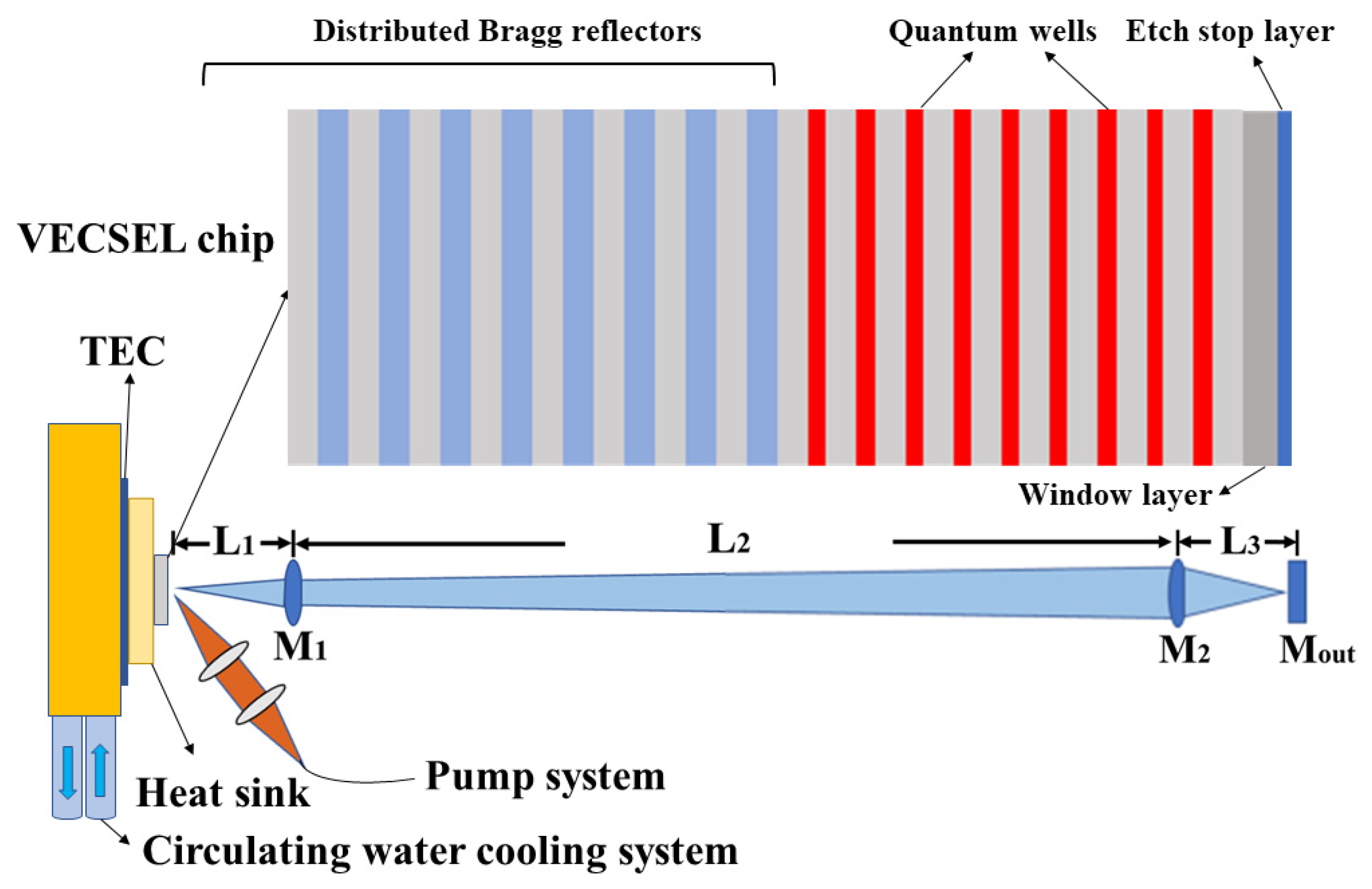
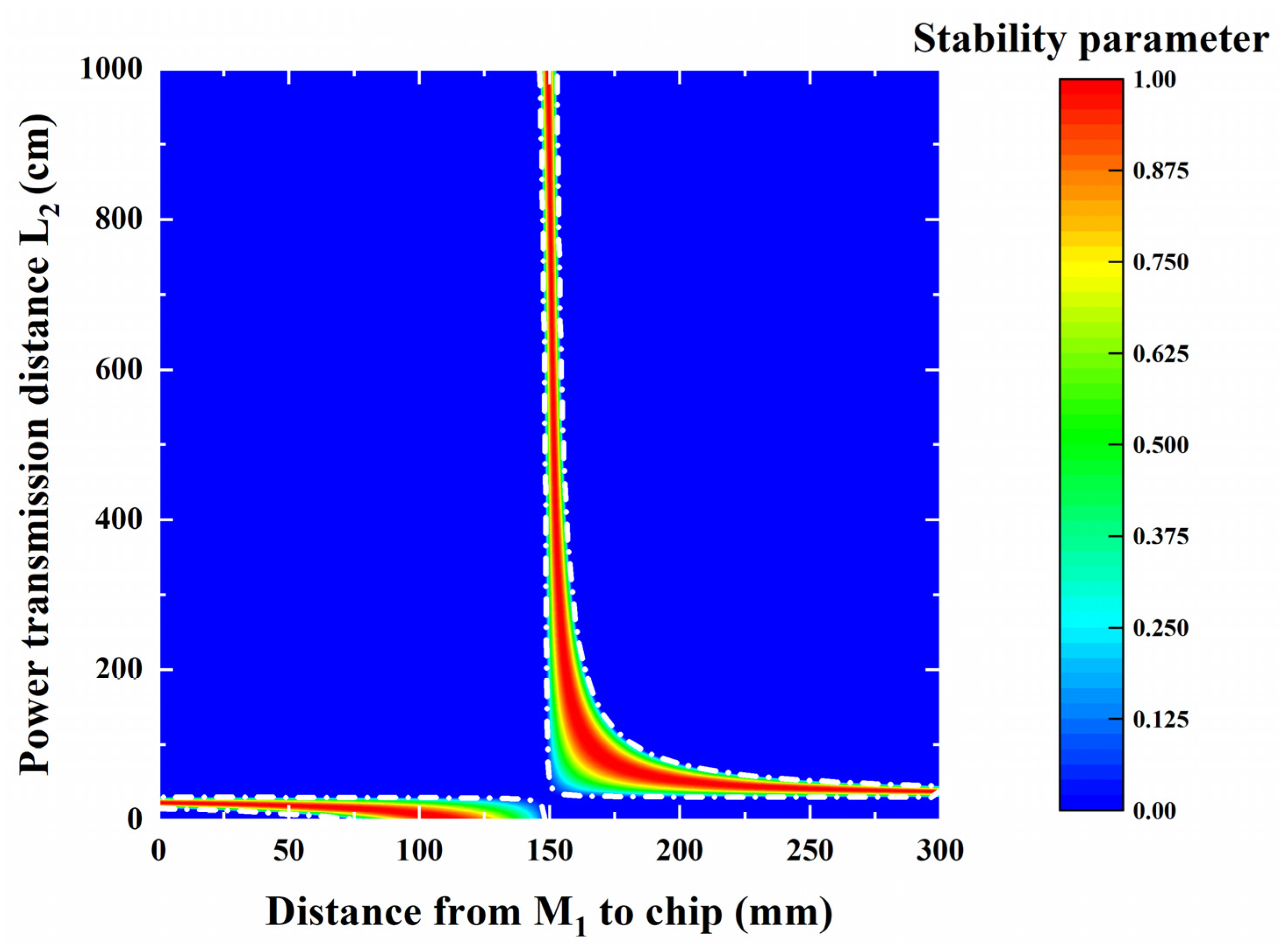

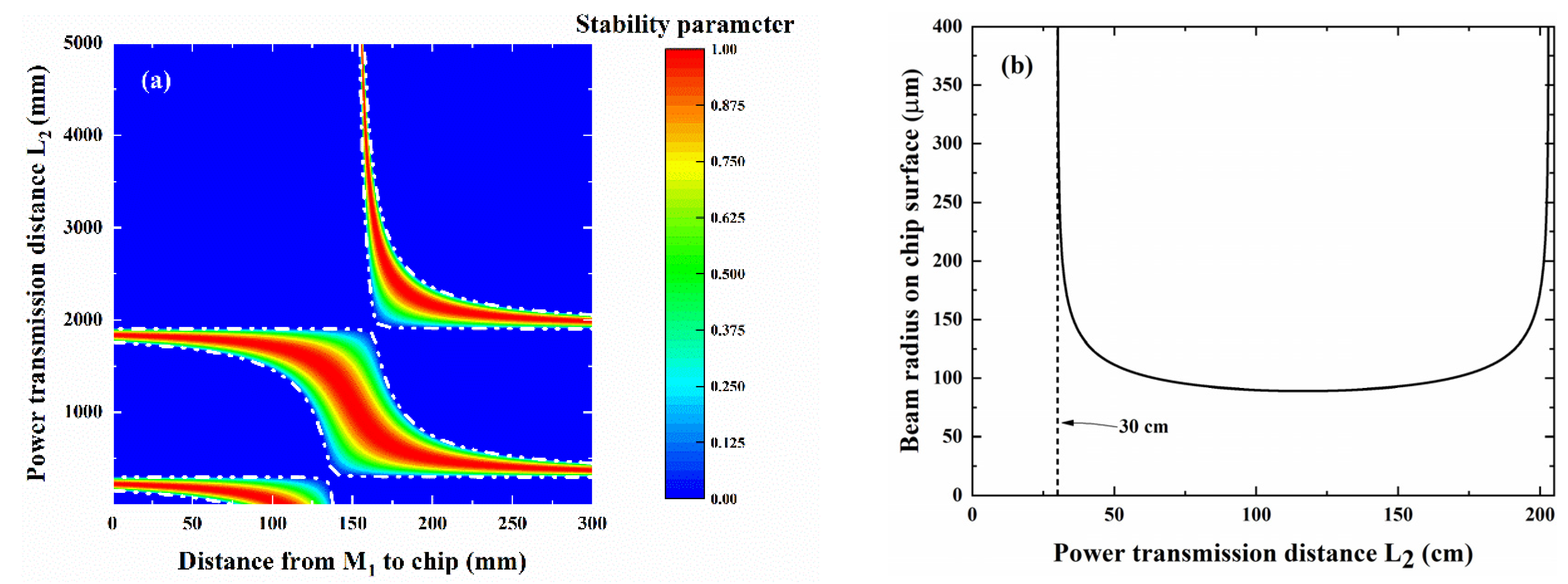

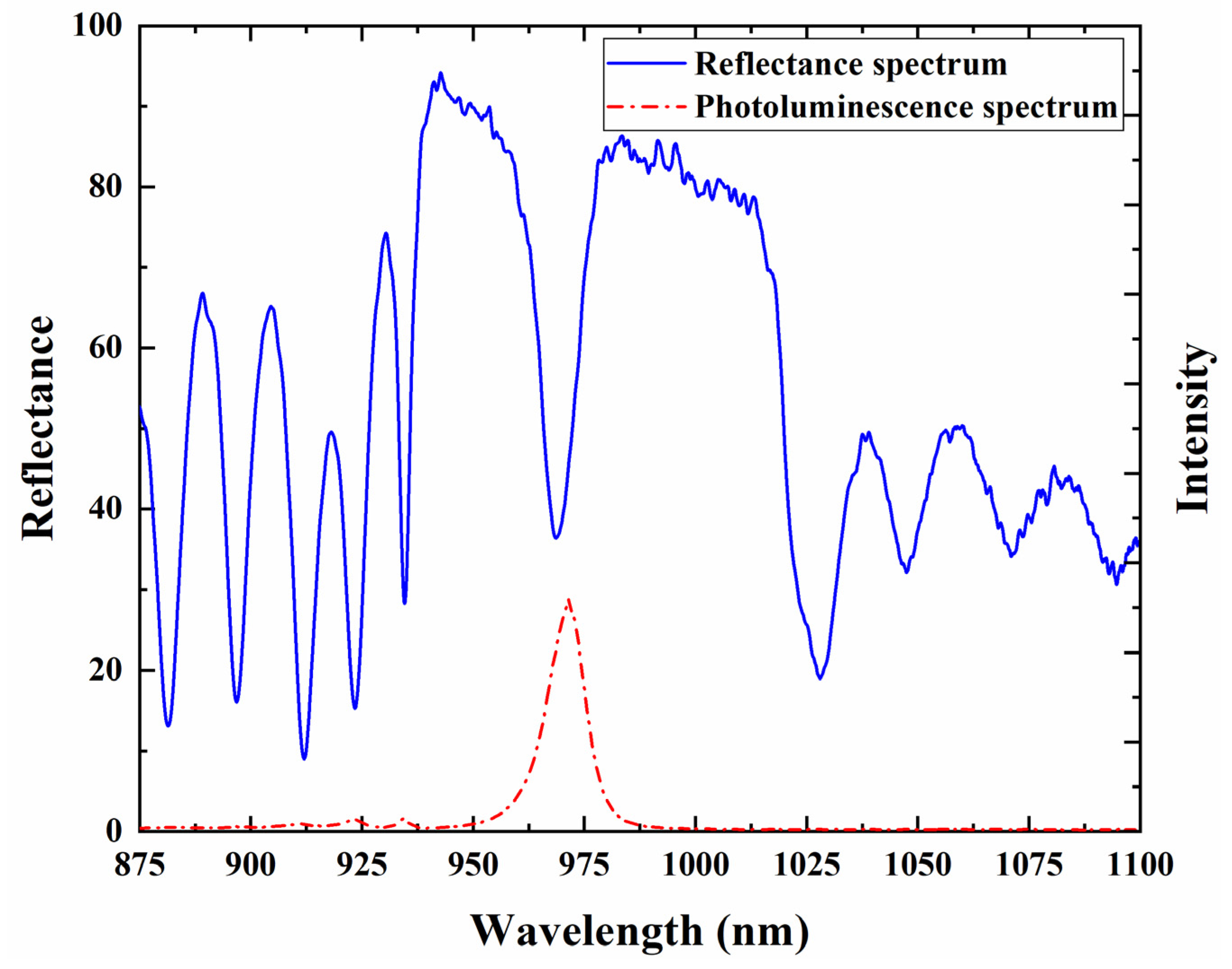

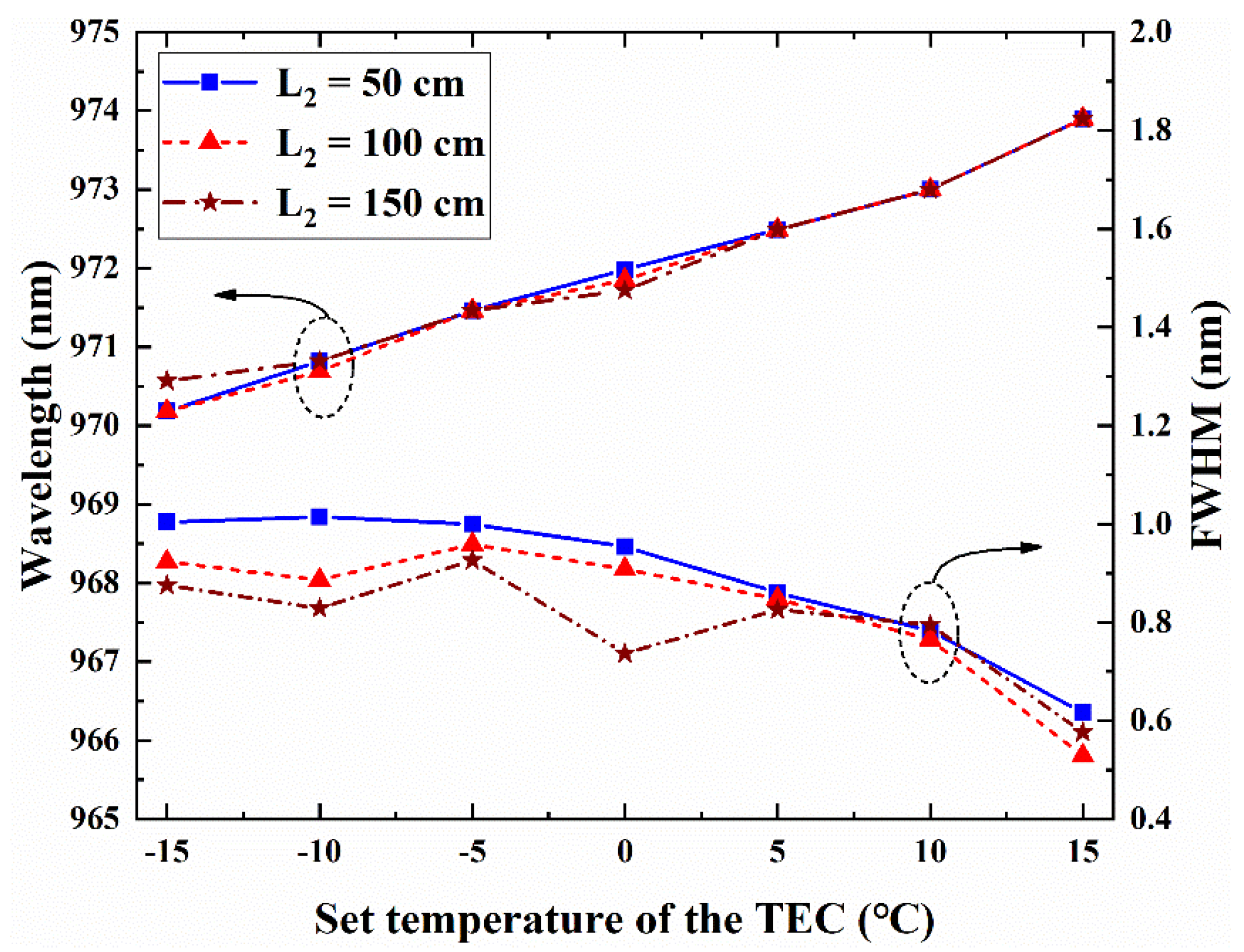

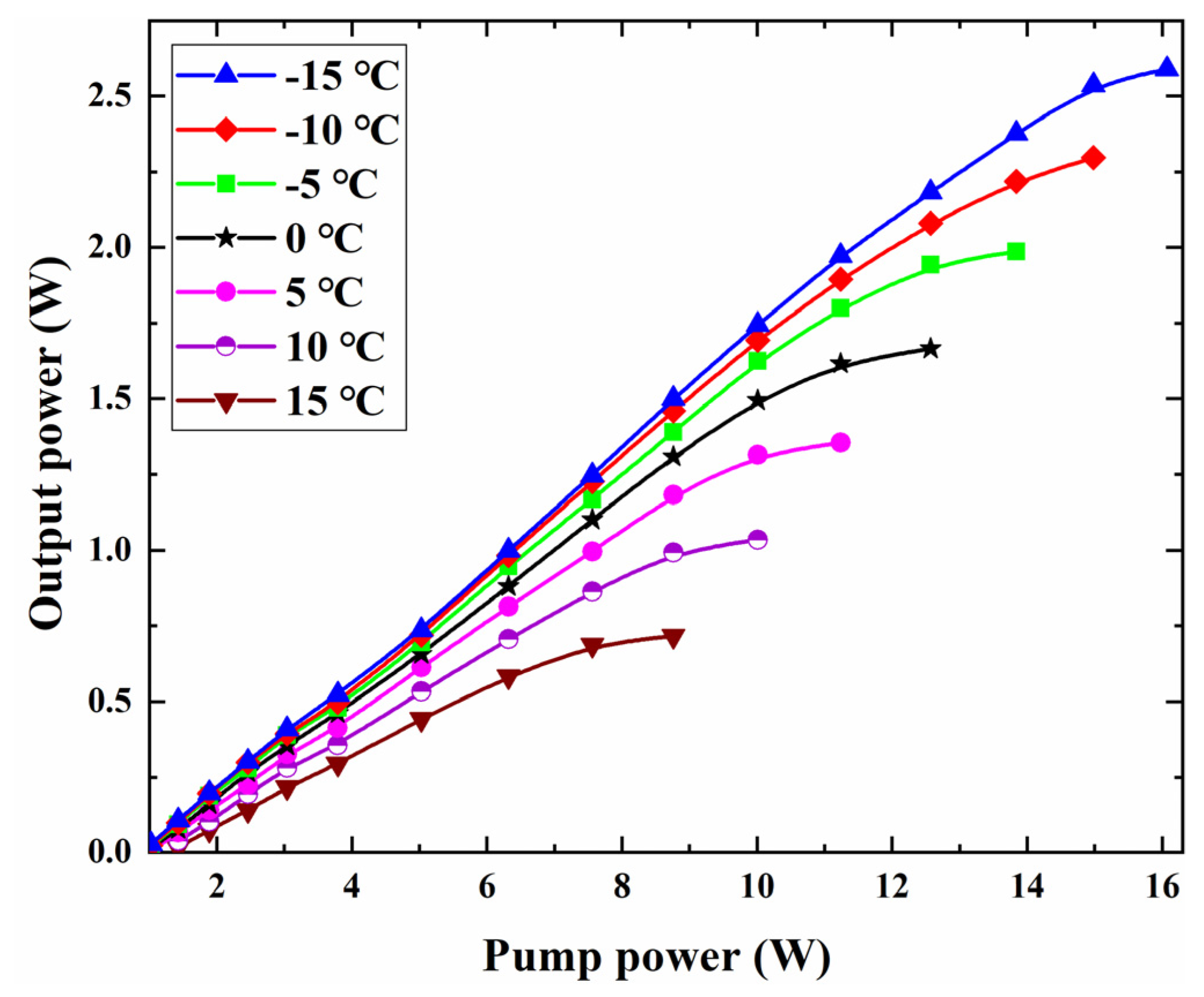
Publisher’s Note: MDPI stays neutral with regard to jurisdictional claims in published maps and institutional affiliations. |
© 2022 by the authors. Licensee MDPI, Basel, Switzerland. This article is an open access article distributed under the terms and conditions of the Creative Commons Attribution (CC BY) license (https://creativecommons.org/licenses/by/4.0/).
Share and Cite
Zhang, Z.; Zhang, J.; Gong, Y.; Zhou, Y.; Zhang, X.; Chen, C.; Wu, H.; Chen, Y.; Qin, L.; Ning, Y.; et al. Long-Distance High-Power Wireless Optical Energy Transmission Based on VECSELs. Crystals 2022, 12, 1475. https://doi.org/10.3390/cryst12101475
Zhang Z, Zhang J, Gong Y, Zhou Y, Zhang X, Chen C, Wu H, Chen Y, Qin L, Ning Y, et al. Long-Distance High-Power Wireless Optical Energy Transmission Based on VECSELs. Crystals. 2022; 12(10):1475. https://doi.org/10.3390/cryst12101475
Chicago/Turabian StyleZhang, Zhuo, Jianwei Zhang, Yuxiang Gong, Yinli Zhou, Xing Zhang, Chao Chen, Hao Wu, Yongyi Chen, Li Qin, Yongqiang Ning, and et al. 2022. "Long-Distance High-Power Wireless Optical Energy Transmission Based on VECSELs" Crystals 12, no. 10: 1475. https://doi.org/10.3390/cryst12101475
APA StyleZhang, Z., Zhang, J., Gong, Y., Zhou, Y., Zhang, X., Chen, C., Wu, H., Chen, Y., Qin, L., Ning, Y., & Wang, L. (2022). Long-Distance High-Power Wireless Optical Energy Transmission Based on VECSELs. Crystals, 12(10), 1475. https://doi.org/10.3390/cryst12101475










